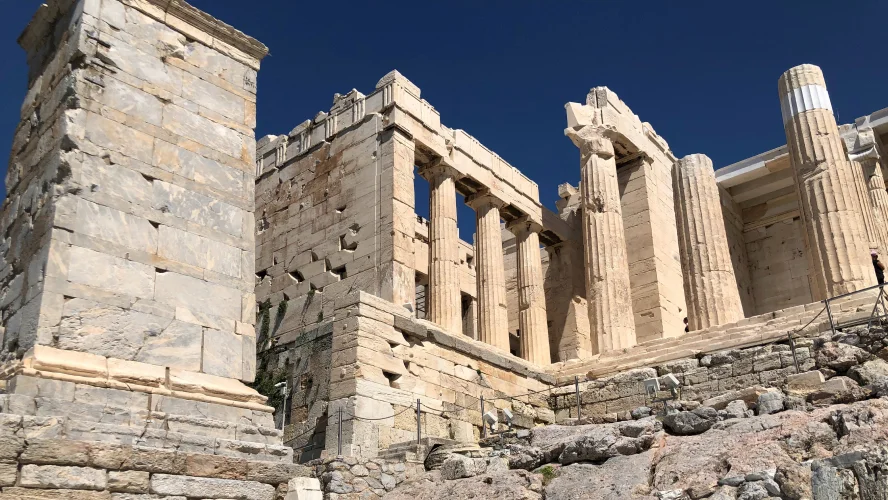
The Acropolis, meaning “high city” in Greek, was constructed as a fortified sanctuary that would serve both religious and defensive purposes. Perched on a rocky outcrop above the city of Athens, it was the epicenter of Athenian life, dedicated primarily to the worship of Athena, the city’s patron goddess. The most iconic structure on the Acropolis, the Parthenon, was built in her honor. The Acropolis also housed other significant temples and structures, such as the Erechtheion, the Temple of Athena Nike, and the Propylaea. These buildings were not only architectural marvels but also expressions of Athenian pride, power, and piety.
One of the most famous myths associated with the Acropolis is the contest between Athena and Poseidon for the patronage of Athens. According to legend, the two gods competed to win the favor of the city’s inhabitants by presenting them with gifts. Poseidon struck the ground with his trident, creating a saltwater spring, symbolizing naval power. Athena, in turn, planted an olive tree, symbolizing peace and prosperity. The citizens of Athens, led by King Cecrops, chose Athena’s gift, and thus she became the city’s patron deity. The olive tree became a sacred symbol, and its presence on the Acropolis is a testament to Athena’s victory and the values she represented.
Another captivating myth involves the birth of Erichthonius, one of the early kings of Athens, who is closely linked to the Acropolis. According to legend, Hephaestus, the god of blacksmiths, attempted to woo Athena but was rebuffed. In the ensuing struggle, Hephaestus’s seed fell to the earth, and from it, Erichthonius was born. Athena, taking pity on the infant, placed him in a chest and entrusted it to the daughters of Cecrops, warning them never to open it. However, curiosity got the better of them, and when they did open the chest, they found the infant entwined with a serpent, a symbol of his divine origin. Overcome with fear, they leaped from the Acropolis to their deaths. Erichthonius would later become a significant figure in Athenian mythology, symbolizing the divine connection between the city and its gods.
The Panathenaic Festival was one of the most important religious and cultural events in ancient Athens, held in honor of Athena. This grand celebration, which took place every four years, involved processions, sacrifices, and athletic competitions. One of the highlights was the presentation of a new peplos (robe) to the statue of Athena. According to myth, the festival’s origins are linked to the divine intervention of Athena in Athenian affairs, showcasing her role as protector and benefactor of the city. The festival also included the legendary musical and poetic contests, where hymns and epics celebrating Athena and the heroes of Athens were performed, reinforcing the cultural and religious significance of the Acropolis.
The story of Arachne is another myth that touches upon the divine presence of Athena in Athenian lore. Arachne was a talented weaver who boasted that her skills were superior to those of Athena. Angered by her hubris, Athena challenged Arachne to a weaving contest. While Arachne’s work was flawless, she depicted the gods in a less favorable light, which infuriated Athena. In her rage, Athena destroyed Arachne’s tapestry and turned her into a spider, condemning her to weave for eternity. This myth underscores the themes of humility and respect for the gods, serving as a moral lesson to the Athenians and reminding them of the divine order represented by the Acropolis.
The legends and myths of the Acropolis of Athens are integral to understanding the cultural and spiritual essence of ancient Athens. These stories not only provide insights into the religious beliefs and moral values of the time but also highlight the profound connection between the city and its patron goddess, Athena. From the contest between Athena and Poseidon to the tales of Erichthonius and Arachne, these myths have left an indelible mark on the heritage of Athens, enriching the legacy of the Acropolis. As visitors walk through the ruins of this ancient citadel, they are not merely witnessing remnants of stone and marble but are also stepping into a realm where history and mythology intertwine, bringing to life the enduring spirit of one of the world’s greatest civilizations.
ACROPOLIS TICKETS
TRAVELER INFORMATION
ACROPOLIS MONUMENTS
The Odeon of Herodes Atticus is a beautifully preserved Roman-era amphitheater located on the south slope of the Acropolis of Ath… see more
